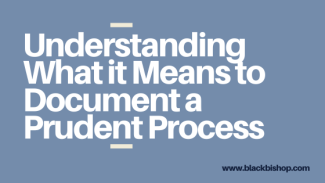
Understanding What It Means to Document a Prudent Process (and Why It’s So Important)
What does it mean to document a prudent process?
When it comes to how you manage your company retirement plan, prudence is the foundation of ERISA’s standard of fiduciary conduct.
ERISA says fiduciaries are to act with “the care, skill, prudence, and diligence of a prudent person acting in a like capacity and familiar with such matters.”
And since prudence focuses on the process by which decisions are made, having a documented process that details all decisions made and the basis for those decisions is a key part of demonstrating prudence.
As a plan fiduciary, you have personal responsibility and liability for the decisions made so undertaking a prudent process can help reduce your risk in the event of a participant lawsuit or audit.
Ways to Document a Prudent Process
There are several areas where documentation is key. Actually, any decision you make on the plan should have documentation in place to justify those decisions ;-)…
Here are some ways you can document a prudent process:
1. Keep a compliance file of all plan records
2. Have - and follow - an investment policy statement
3. Meet regularly with your committee and service providers
4. Keep detailed minutes of any plan meeting (or discussion) where plan decisions are made and/or discussed including what material was reviewed and what decisions were made
5. Include in the documentation the reasons decisions were made a certain way
6. Regularly review all plan documents against your plan process (they should match) and document your plan reviews
Examples That Demonstrate the Importance of a Documented Process
Thanks to a well-documented process, American Century was able to stop an excessive fee suit filed by one of their participants in its 401(k) plan.
Some of the claims in the Wildman v. Am. Century Servcs. suit included breach of fiduciary duty, failure to monitor fiduciaries, duplicate funds, no index fund options, holding only proprietary funds, and failure to properly monitor and replace funds.
On every point, the plaintiffs had a documented process that showed what information they reviewed and considered, the reasons for holding certain funds or asset classes, and detailed minutes of all decisions made.
The allegations made were refuted by documentation that revealed a prudent process was undertaken and the court ruled in favor of the defendants on all counts.
Another case where prudent process prevailed was the Scalia v. WPN Corp. suit. A Pension fund which at one time totaled nearly $50 million, suffered more than a $15 million dollar loss when the vast majority of the funds’ assets remained undiversified for a period of months in a small portfolio of energy stocks. The DOL sued the investment manager and then went after the committee.
The claim against the committee was that the committee failed to prudently monitor the investment manager. After almost five years of litigation, the District Court entered a summary judgment in favor of the retirement plan committee.
The committee was able to point to a specific paper trail and were able to prove its prudence through specific documents to support appropriate monitoring had taken place. They documented all major decisions in writing, kept detailed minutes of committee meetings, and documented their activities in writing in real-time.
In both cases just discussed, if the documentation had not been there to support a prudent decision-making process, the results most likely would not have turned out in the plan sponsors’ favor.
What Should Be in Your Compliance File?
If you don’t currently have your plan documents organized and centralized so in the event of an audit or lawsuit, you could quickly and easily present your documented plan management process, let us start by sending you a compliance file checklist. Contact us and we’ll email it right over. And if you want assistance with building a paper trail that helps limit your liability, we’d be happy to set up a call and discuss how we might work together.

